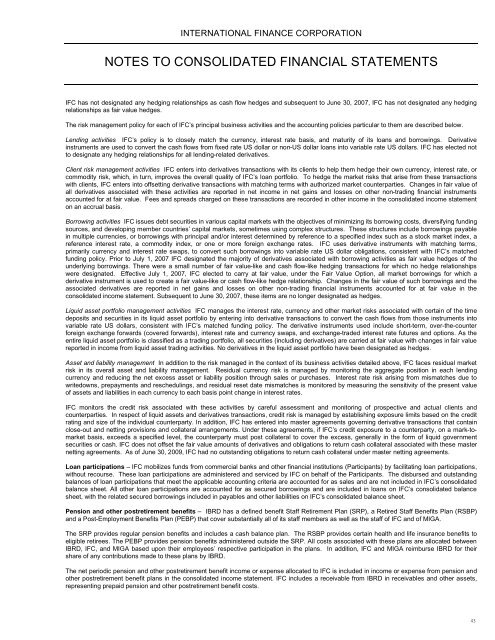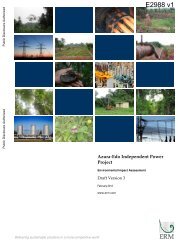Volume 2 - IFC
Volume 2 - IFC
Volume 2 - IFC
You also want an ePaper? Increase the reach of your titles
YUMPU automatically turns print PDFs into web optimized ePapers that Google loves.
INTERNATIONAL FINANCE CORPORATION<br />
NOTES TO CONSOLIDATED FINANCIAL STATEMENTS<br />
<strong>IFC</strong> has not designated any hedging relationships as cash flow hedges and subsequent to June 30, 2007, <strong>IFC</strong> has not designated any hedging<br />
relationships as fair value hedges.<br />
The risk management policy for each of <strong>IFC</strong>’s principal business activities and the accounting policies particular to them are described below.<br />
Lending activities <strong>IFC</strong>’s policy is to closely match the currency, interest rate basis, and maturity of its loans and borrowings. Derivative<br />
instruments are used to convert the cash flows from fixed rate US dollar or non-US dollar loans into variable rate US dollars. <strong>IFC</strong> has elected not<br />
to designate any hedging relationships for all lending-related derivatives.<br />
Client risk management activities <strong>IFC</strong> enters into derivatives transactions with its clients to help them hedge their own currency, interest rate, or<br />
commodity risk, which, in turn, improves the overall quality of <strong>IFC</strong>’s loan portfolio. To hedge the market risks that arise from these transactions<br />
with clients, <strong>IFC</strong> enters into offsetting derivative transactions with matching terms with authorized market counterparties. Changes in fair value of<br />
all derivatives associated with these activities are reported in net income in net gains and losses on other non-trading financial instruments<br />
accounted for at fair value. Fees and spreads charged on these transactions are recorded in other income in the consolidated income statement<br />
on an accrual basis.<br />
Borrowing activities <strong>IFC</strong> issues debt securities in various capital markets with the objectives of minimizing its borrowing costs, diversifying funding<br />
sources, and developing member countries’ capital markets, sometimes using complex structures. These structures include borrowings payable<br />
in multiple currencies, or borrowings with principal and/or interest determined by reference to a specified index such as a stock market index, a<br />
reference interest rate, a commodity index, or one or more foreign exchange rates. <strong>IFC</strong> uses derivative instruments with matching terms,<br />
primarily currency and interest rate swaps, to convert such borrowings into variable rate US dollar obligations, consistent with <strong>IFC</strong>’s matched<br />
funding policy. Prior to July 1, 2007 <strong>IFC</strong> designated the majority of derivatives associated with borrowing activities as fair value hedges of the<br />
underlying borrowings. There were a small number of fair value-like and cash flow-like hedging transactions for which no hedge relationships<br />
were designated. Effective July 1, 2007, <strong>IFC</strong> elected to carry at fair value, under the Fair Value Option, all market borrowings for which a<br />
derivative instrument is used to create a fair value-like or cash flow-like hedge relationship. Changes in the fair value of such borrowings and the<br />
associated derivatives are reported in net gains and losses on other non-trading financial instruments accounted for at fair value in the<br />
consolidated income statement. Subsequent to June 30, 2007, these items are no longer designated as hedges.<br />
Liquid asset portfolio management activities <strong>IFC</strong> manages the interest rate, currency and other market risks associated with certain of the time<br />
deposits and securities in its liquid asset portfolio by entering into derivative transactions to convert the cash flows from those instruments into<br />
variable rate US dollars, consistent with <strong>IFC</strong>’s matched funding policy. The derivative instruments used include short-term, over-the-counter<br />
foreign exchange forwards (covered forwards), interest rate and currency swaps, and exchange-traded interest rate futures and options. As the<br />
entire liquid asset portfolio is classified as a trading portfolio, all securities (including derivatives) are carried at fair value with changes in fair value<br />
reported in income from liquid asset trading activities. No derivatives in the liquid asset portfolio have been designated as hedges.<br />
Asset and liability management In addition to the risk managed in the context of its business activities detailed above, <strong>IFC</strong> faces residual market<br />
risk in its overall asset and liability management. Residual currency risk is managed by monitoring the aggregate position in each lending<br />
currency and reducing the net excess asset or liability position through sales or purchases. Interest rate risk arising from mismatches due to<br />
writedowns, prepayments and reschedulings, and residual reset date mismatches is monitored by measuring the sensitivity of the present value<br />
of assets and liabilities in each currency to each basis point change in interest rates.<br />
<strong>IFC</strong> monitors the credit risk associated with these activities by careful assessment and monitoring of prospective and actual clients and<br />
counterparties. In respect of liquid assets and derivatives transactions, credit risk is managed by establishing exposure limits based on the credit<br />
rating and size of the individual counterparty. In addition, <strong>IFC</strong> has entered into master agreements governing derivative transactions that contain<br />
close-out and netting provisions and collateral arrangements. Under these agreements, if <strong>IFC</strong>’s credit exposure to a counterparty, on a mark-tomarket<br />
basis, exceeds a specified level, the counterparty must post collateral to cover the excess, generally in the form of liquid government<br />
securities or cash. <strong>IFC</strong> does not offset the fair value amounts of derivatives and obligations to return cash collateral associated with these master<br />
netting agreements. As of June 30, 2009, <strong>IFC</strong> had no outstanding obligations to return cash collateral under master netting agreements.<br />
Loan participations – <strong>IFC</strong> mobilizes funds from commercial banks and other financial institutions (Participants) by facilitating loan participations,<br />
without recourse. These loan participations are administered and serviced by <strong>IFC</strong> on behalf of the Participants. The disbursed and outstanding<br />
balances of loan participations that meet the applicable accounting criteria are accounted for as sales and are not included in <strong>IFC</strong>’s consolidated<br />
balance sheet. All other loan participations are accounted for as secured borrowings and are included in loans on <strong>IFC</strong>’s consolidated balance<br />
sheet, with the related secured borrowings included in payables and other liabilities on <strong>IFC</strong>’s consolidated balance sheet.<br />
Pension and other postretirement benefits – IBRD has a defined benefit Staff Retirement Plan (SRP), a Retired Staff Benefits Plan (RSBP)<br />
and a Post-Employment Benefits Plan (PEBP) that cover substantially all of its staff members as well as the staff of <strong>IFC</strong> and of MIGA.<br />
The SRP provides regular pension benefits and includes a cash balance plan. The RSBP provides certain health and life insurance benefits to<br />
eligible retirees. The PEBP provides pension benefits administered outside the SRP. All costs associated with these plans are allocated between<br />
IBRD, <strong>IFC</strong>, and MIGA based upon their employees’ respective participation in the plans. In addition, <strong>IFC</strong> and MIGA reimburse IBRD for their<br />
share of any contributions made to these plans by IBRD.<br />
The net periodic pension and other postretirement benefit income or expense allocated to <strong>IFC</strong> is included in income or expense from pension and<br />
other postretirement benefit plans in the consolidated income statement. <strong>IFC</strong> includes a receivable from IBRD in receivables and other assets,<br />
representing prepaid pension and other postretirement benefit costs.<br />
43
















